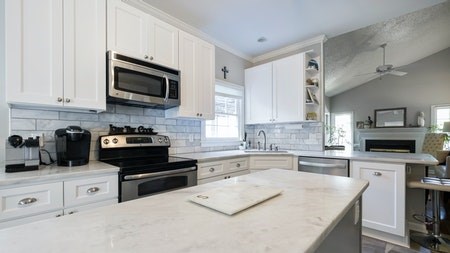Many homeowners consider switching to a more eco-friendly lifestyle, and home appliances are an excellent place to start. Appliances are essential for modern lifestyles, but you need to consider your carbon footprint when buying new ones.
Even if your existing appliances are in working order, there is still a solid case to be made for replacing them if they are not energy-efficient. Dated appliances like fridges, freezers and washing machines generally use far more water and energy than modern appliances. Replacing them with eco-friendly models could significantly lower your monthly utility bills.
Labelled
To inform consumers about the relative energy efficiency of an appliance before they decide to purchase, the Department of Mineral Resources and Energy has put in place appliance standards and labelling regulations. As a result, several appliances are now required to be labelled with a South African Energy Efficiency Label.
The labels are designed to provide consumers with accurate and comparative information on the energy efficiency of household appliances. The label must be visible on the following appliances in both physical and online stores:
- Washing machines
- Tumble driers
- Combination washer/driers
- Dishwashers
- Electric ovens
- Fridges and freezers
- Air conditioners
- Hot water cylinders (geysers)
Labelling is optional for electric light bulbs.
The label's information indicates the appliance's energy efficiency class, the manufacturer and the appliance model. In addition, the label will display non-energy data such as water consumption per cycle and appliance noise level for some appliances.
Labels for various categories of appliances differ depending on the function of the appliance. However, all labels include seven energy efficiency classes, and the energy efficiency class of the particular appliance is labelled clearly.
Each label has seven horizontal colour coded bars extending from left to right, ranging from dark green on top to dark red at the bottom. Each colour-coded bar reflects an energy efficiency threshold for a particular appliance. In addition, the actual energy efficiency class of each appliance is indicated by a white letter on a short black coded bar in the column, extending from right to left.
The most energy-efficient appliances have an energy class corresponding with the dark green energy efficiency bar.
Energy usage for appliances that are usually operated continuously - like refrigerators and hot water cylinders - is shown in kWh per year.
Energy usage for appliances used when needed - like washing machines and dishwashers - is expressed in kWh per cycle.
A detailed guide to energy efficiency labelling has been developed to help consumers understand the information on the labels and provide manufacturers with exact labelling requirements.
Appliances
In addition to energy efficiency, you need to take into account your specific needs.
When choosing a washing machine, for instance, you need to consider the following:
- Do you want a top-loader or a front loader? Front-loaders fit under most countertops, and modern machines generally cope with up to 7 kg loads. Usually big enough for a family of four. Top loaders can usually take larger loads but can't be installed under a countertop.
- A combination washer/drier might be helpful if you live in a flat with limited space for appliances and inadequate drying facilities.
- A stainless-steel drum is the most expensive option. However, it is also more durable than other drums, so it will work out cheaper in the long run.
Before choosing a dishwasher, you need to know the following:
The number of place settings measures the capacity of a dishwasher. A place setting consists of one soup bowl, one dinner plate, one dessert bowl, one cup and saucer, one drinking glass and a knife, a fork, a soup spoon, a dessert spoon and a teaspoon.
The number of people living in your household also need to be taken into account. For example, a family of four will usually fill and run a 14-place dishwasher daily.
Wash cycles. Look for dishwashers with eco cycles, which use less water and electricity. In addition to general wash cycles, some dishwashers have an express cycle. The express cycle speeds up the washing-up process, saving time if you need to get clean dishes out in a hurry. However, it uses more water and electricity than the regular cycles.
Racks. All models have a bottom and a top rack, but some have adjustable top racks so that you can increase the height of the upper basket if you want to place large pots in the lower basket and need more headroom.
Most models have removable cutlery baskets, making it easier to unpack knives and forks straight into the cutlery drawer.
Choose a fridge/freezer that fits your storage needs. For example, if you keep lots of items on ice for long periods, choose one with plenty of freezer space.
You might need dedicated compartments for cold meats, dairy or cheese in the fridge.
If you want an ice maker or a water dispenser, make sure there is a water supply nearby.
No matter what fridge style you choose, make sure it will fit into the same space as your current model. Measure the dimensions of your old unit, then compare these with the new fridge. Ideally, the replacement will be the same size or smaller than your old model.
Also, measure your counter depth and how much clearance you have to open the fridge doors or walk past the fridge. Some fridges are more profound than standard counters, so they’ll jut out into your kitchen.
To avoid unexpected complications when your new fridge is delivered, look at entry points - including doors, hallways and passages – and the rest of the path delivery people will take.
Budget
Last but not least, which new appliance you decide on will depend on your budget.
It's essential to research before stepping into an appliance showroom. Researching will give you a realistic idea of how much it is reasonable to spend.
The best plan is not to be so rigid in the budget that you pass up an appliance that would be ideal for you and your family in the long term because it goes over budget. Instead, it may be worth saving a little longer to get just what you need.





